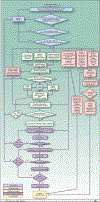Translational Research Working Group developmental pathway for immune response modifiers
- PMID: 18794077
- PMCID: PMC6383515
- DOI: 10.1158/1078-0432.CCR-08-1266
Translational Research Working Group developmental pathway for immune response modifiers
Abstract
The Translational Research Working Group (TRWG) was created as a national initiative to evaluate the current status of the investment of National Cancer Institute in translational research and envision its future. The Translational Research Working Group conceptualized translational research as a set of six developmental processes or pathways focused on various clinical goals. One of those pathways describes the development of immune response modifiers such as vaccines and cytokines. A hallmark of the Immune Response Modifier Developmental Pathway is the coordinated development of multiple components. The Immune Response Modifier Pathway was conceived not as a comprehensive description of the corresponding real-world processes but rather as a tool designed to facilitate movement of a candidate assay through the translational process to the point where it can be handed off for definitive clinical testing. This paper discusses key challenges associated with the immune response modifier agent development process in light of the pathway.
Conflict of interest statement
Disclosure of Potential Conflicts of Interest
No potential conflicts of interest were disclosed.
Figures

Similar articles
-
The Translational Research Working Group developmental pathway for anticancer agents (drugs or biologics).Clin Cancer Res. 2008 Sep 15;14(18):5685-91. doi: 10.1158/1078-0432.CCR-08-1265. Clin Cancer Res. 2008. PMID: 18794076 Free PMC article.
-
Translational Research Working Group developmental pathway for biospecimen-based assessment modalities.Clin Cancer Res. 2008 Sep 15;14(18):5672-7. doi: 10.1158/1078-0432.CCR-08-1267. Clin Cancer Res. 2008. PMID: 18794074 Free PMC article.
-
The Translational Research Working Group developmental pathway for lifestyle alterations.Clin Cancer Res. 2008 Sep 15;14(18):5707-13. doi: 10.1158/1078-0432.CCR-08-1262. Clin Cancer Res. 2008. PMID: 18794079
-
Biological response modifiers in cancer.MedGenMed. 2006 Nov 14;8(4):33. MedGenMed. 2006. PMID: 17415315 Free PMC article. Review.
-
[Current status and future perspective of cancer immunotherapy--clinical application and development].Nihon Geka Gakkai Zasshi. 2013 Nov;114(6):327-31. Nihon Geka Gakkai Zasshi. 2013. PMID: 24358730 Review. Japanese. No abstract available.
Cited by
-
The Concept of Hormesis in Cancer Therapy - Is Less More?Cureus. 2015 Apr 2;7(4):e261. doi: 10.7759/cureus.261. eCollection 2015 Apr. Cureus. 2015. PMID: 26180685 Free PMC article. Review.
-
Multiple vaccinations: friend or foe.Cancer J. 2011 Sep-Oct;17(5):379-96. doi: 10.1097/PPO.0b013e3182346320. Cancer J. 2011. PMID: 21952289 Free PMC article. Review.
-
Nanovectorized radiotherapy: a new strategy to induce anti-tumor immunity.Front Oncol. 2012 Oct 10;2:136. doi: 10.3389/fonc.2012.00136. eCollection 2012. Front Oncol. 2012. PMID: 23087900 Free PMC article.
-
Strategies for developing and optimizing cancer vaccines.F1000Res. 2019 May 13;8:F1000 Faculty Rev-654. doi: 10.12688/f1000research.18693.1. eCollection 2019. F1000Res. 2019. PMID: 31131086 Free PMC article. Review.
-
Cancer immunotherapy comes of age.Nature. 2011 Dec 21;480(7378):480-9. doi: 10.1038/nature10673. Nature. 2011. PMID: 22193102 Free PMC article. Review.
References
-
- Hawk ET, Matrisian LM, Nelson WG, et al. Translational Research Working Group developmental pathways: introduction and overview. Clin Cancer Res 2008;14: 5664–71. - PubMed
-
- Mihich E Combined effects of chemotherapy and immunity against Leukemia L1210 in DBA/2 Mice. Cancer Res 1969;29:848–54. - PubMed
-
- Arlen PM, Gulley JL, Madan RA, Hodge JW, Schlom J. Preclinical and clinical studies of recombinant poxvirus vaccines for carcinoma therapy. Crit Rev Immunol 2007;27:451–62. - PubMed
-
- Finn OJ. Cancer Immunology. N Engl J Med 2008; 58:2704–15. - PubMed
MeSH terms
Substances
Grants and funding
LinkOut - more resources
Full Text Sources
Other Literature Sources

